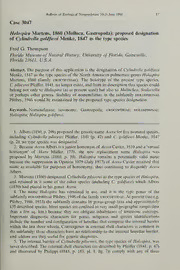
Case 3047. Holospira Martens, 1860 (Mollusca, Gastropoda): proposed designation of Cylindrella goldfussi Menke, 1847 as the type species PDF
Preview Case 3047. Holospira Martens, 1860 (Mollusca, Gastropoda): proposed designation of Cylindrella goldfussi Menke, 1847 as the type species
BulletinofZoological Nomenclature55(2)June 1998 87 Case 3047 Holospira Martens, 1860 (Molluca, Gastropoda): proposed designation of Cylindrella goldfussi Menke, 1847 as the type species Fred G. Thompson Florida Museum ofNatural History, University ofFlorida. Gainesville, Florida 23611. U.S.A. Abstract.The purpose of this application is the designation of Cylindrella goldfussi Menke, 1847 as the type species ofthe North American pulmonate genus Holospira Martens, 1860 (family urocoptidae). The holotype of the present type species, C.pilocereiPfeiffer, 1841, nolongerexists,andfromitsdescription thatspeciescould belong not only to Holospira (as at present used) but also to Malinchea, Stalaclella or perhaps other genera. Stability of nomenclature in the subfamily holospirinae Pilsbry, 1946 would be maintained by the proposed type species designation. Keywords. Nomenclature; taxonomy; Gastropoda; urocoptidae; holospirinae; Holospira; Holospira goldfussi. 1. Albers (1850,p. 209)proposed thegeneric nameAceraforfive nominalspecies, including Cylindrella pilocerei Pfeiffer, 1841 (p. 47) and C goldfussi Menke, 1847 (p. 2); no type species was designated. 2. BecauseAceraAlbersisajuniorhomonymoiAceraCuvier, 1810anda'virtual homonym' of Akera Miiller, 1776, the new replacement name Holospira was proposed by Martens (1860, p. 39). Holospira remains a potentially valid name because the suppression in Opinion 1079 (July 1977) oi.Accra Cuvier retained that name as available for purposes of homonymy, thus continuing to disquahfy Acera Albers. 3. Martens(1860)designated Cylindrellapilocereiasthetype speciesofHolospira, and retained in it some of the other species (including C goldfussi) which Albers (1850) had placed in his genus Acera. 4. The name Holospira has remained in use, and it is the type genus of the subfamilyholospirinae Pilsbry, 1946ofthefamilyurocoptidae. Atpresent(seee.g. Pilsbry. 1946, 1953) the subfamily contains 16 genus-group taxa and approximately 135describedspecies. Most speciesareconfinedtoverysmall geographicranges(less than a few sq. km.) because they are obligate inhabitants of limestone outcrops. Important diagnostic characters for genus, subgenus and species identifications include the number and configuration oflamellae that comprise the internal barrier within the last three whorls. Convergence in external shell characters is common in the subfamily; these characters have no relationship to the internal lamellar barrier, and seldom are they useful for generic diagnoses. 5. The internal barrier of Cylindrellapilocerei, the type species ofHolospira, was never described. The external shell characters (as described by Pfeiffer (1841, p. 47) and illustrated by Philippi (1845, p. 183, pi. 1, fig. 7)) comply with any of three ) 88 Bulletin ofZoological Nomenclature 55(2)June 1998 genus-group taxa that occur in the general region of its type locahty: Holospira, Sialactellu Bartsch, 1906 and Malincheu Bartsch, 1945. The species may also belong to some other genus. Holospira (as currently understood) has tour smooth internal lamellae, whereas Malinchea has three and Slalactella has only two, one ofwhich is spinose. The holotype ofC. pilocereihas not been located in the collections where it might be expected (the Berlin Museum, the Senckenberg Museum, or the Natural History Museum, London), and it was probably destroyed during World War II togetherwith most ofthe Pfeiffercollection in Berlin. Attempts in 1992 tocollect the species at the type locality (Cuantla de las Amilpas, Puebla [Morelas], Mexico) were unsuccessful. The area is over-grazed by goat herding and intensely disturbed by other human uses; no population ofany holospirid was found, and C. pilocerei is presumed to be extinct at its type locality. 6. The name Cylindrella pilocerei must be regarded as a nomen dubium, and the nominal species is ofno utility for characterizing Holospira. The current concept of thegenus isbasedon themorphology ofotherspeciesthat havelongbeenassociated with it (Pilsbry, 1902 (p. 666), 1946(p. 115), 1953 (p. 141); Gilbertson, 1993 (p. 79)). Amongst these istheTexan CylindrellagoldfussiMenke, 1847, which isan originally includedspeciesofHolospira(paras. 1 and 3 above)andhassincealwaysbeenplaced in the genus. The diagnostic features ofthe internal barrier ofthis species have been well described (see Pilsbry, 1946, p. 115) and syntypes are in the Natural History Museum, London. Nomenclatural stability in Holospira and more generally in the HOLOSPiRiNAEwould be maintained by the designation ofCylindrellagoldfussias the type species. 7. The International Commission on Zoological Nomenclature is accordingly asked: (1 to use its plenary powers to set aside all previous fixations oftype species for the nominal genus Holospira Martens, 1860 and to designate Cylindrella goldfussi Menke, 1847 as the type species; (2) to place on the Official List ofGeneric Names in Zoology the name Holospira Martens, 1860 (gender: feminine), type species by designation in (I) above Cylindrella goldfussi Menke, 1847; (3) to place on the Official List ofSpecific Names in Zoology the name goldfussi Menke, 1847, as published in the binomen Cylindrellagoldfussi(specificname ofthe type species ofHolospira Martens, I860). References Albers,.I.C. 1850. DieHeliceen. nacliluiliirlic/ier Vcrvaiidlschaflsysienmlischgcordnet. 262pp. Berlin. Gilbertson, L.H. 1993. Reproductive anatomies of Huhspira spp. (Gastropoda: Pulmonata: Urocoptidiie) from Arizona and Sonera, with a new subgenus and a new subspecies. American MalacologicatBidtelin. 10: 71-81. Martens, E. von. 1860. In Albers. J.C. Die Heliceen. nach naiiirlichcr \'ervcmdl.schaft systemati.Kchgeordnet, Ed. 2. 359 pp. Engclmann. Leipzig. Menke, K.T. 1847. Vier neue Arten der Galtung Cylindrella Pfr. Zeitschrift fiir Malako- zoohgic. 1847(1): 1-3. Pfeiffer, L. 1841. Symbolaeadhisloriwn Heliceonini. 88 pp. Casselis. Philippi. R.A. [1842]-1851. AhhiUhmgen wul Beschrcihungcn neuer odcr wcnig gckannter Conchylien, vol. 1. 204 pp. Cassel. . Bulletin ofZoologicalNomenclature 55(2)June 1998 89 Pilsbry, H.A. 1902. ManualofConchology. ser. 2, vol. 15. 323 pp. Philadelphia. Pilsbry, H.A. 1946. Land Molhisca of North America (north of Mexico). Monograph, Academy ofNatural Sciences ofPhiladelphia, 3, vol. 2, part I. v. 520 pp. Pilsbry, H.A. 1953. Inland Mollusca of northern Mexico. II. Urocoptidae. Pupillidae, Strobilopsidae, Valloniidae, and Cionellidae. Proceedings of the Academy of Natural SciencesofPhiladelphia. \Q5: \3i-\61 Comments on this case are invited for publication (subject to editing) in the Bulletin: they should be sent to the Executive Secretary, I.C.Z.N., c/o The Natural History Museum, Cromwell Road, London SW7 5BD, U.K. (e-mail: iczn(g!nhm.ac.uk).
